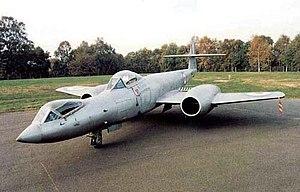Gloster Meteor F8 "Prone Pilot"
| WK935 | |
|---|---|
 |
|
| Type | Fighter Gloster Meteor F8 |
| Manufacturer | Armstrong-Whitworth |
| Serial | WK935 |
| First flight | 10 February 1954 |
| Owners and operators | Royal Air Force |
A much modified Gloster Meteor F8 fighter, the "prone position/prone pilot" Meteor, was used to evaluate the effects of acceleration/inertia-induced forces while flying in a prone position. Along with the Reid and Sigrist R.S.4 "Bobsleigh", the Gloster Meteor was engaged in a proof-of-concept experimental programme that proved in practice that the difficulties of operating the controls of the aircraft outweighed the advantages of sustaining higher "g" effects.
In the early 1950s the adoption of a prone position cockpit in future combat aircraft designs appeared attractive for two reasons. Firstly, such a configuration enabled the frontal area of the airframe to be reduced and therefore reduced drag. Secondly, aircrew can withstand greater inertial forces if not sitting upright, a vital consideration given the need for jet combat aircraft to manoeuvre at ever increasing speeds. While the Reid and Sigrist R.S.4 "Bobsleigh" explored low speed performance 1951–1956, the Royal Air Force soon also needed a higher performance concept aircraft.
The Bristol Aeroplane Company sought to exploit these advantages by incorporating a prone pilot position in its proposal for a rocket-powered fighter, the Bristol Type 185. In order to establish the viability of a prone pilot cockpit, the RAF Institute of Aviation Medicine required a jet aircraft that could be flown in experimental flight tests. The last production Meteor F8 WK935 built by Armstrong-Whitworth was selected for modification and joined the Institute of Aviation Medicine in autumn 1954.
Armstrong-Whitworth carried out all the modifications as an "in-house" project. A standard fighter cockpit was retained; WK935 was never flown solo from the radically modified front cockpit, which incorporated a custom-built couch, offset tiny control column, and suspended rear pedals. A Meteor NF 12 tail unit was substituted for the usual F8 tail. The Armstrong-Whitworth Chief Test Pilot Eric George Franklin carried out the test flights.
The prone pilot's emergency escape involved an extremely complex procedure which included jettisoning the rudder pedals, crawling backward to an escape hatch and retracting the nose wheel. Fortunately, this system was never used.
...
Wikipedia
